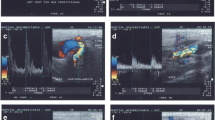Abstract
Ultrasound Doppler echography (USDE) of large peripheral blood vessels was performed in 110 patients with fractures in diaphyses of long tubular bones of the lower extremities. The USDE data and factor analysis of hemodynamic parameters (systolic and retrograde blood flow, blood pressure, pulse index) are presented. Compensatory mechanisms of the peripheral blood flow that are generated upon traumatic and gunshot fractures are considered.
Similar content being viewed by others
REFERENCES
Zubarev, A.R. and Grigoryan, R.A., Ul'trazvukovoe angioskanirovanie (Ultrasound Angioscanning), Moscow: Meditsina, 1991.
Abu Rahma, A.F., Duthrich, E.B., and Reiling, M., Doppler Testing of Peripheral Vascular Occlusive Disease, Surg. Obstet., 1980, vol. 150, no. 1, p. 26.
Woodcock, J.P., Doppler Ultrasound in Clinical Diagnosis, Br. Med. Bull., 1980, vol. 36, no. 3, p. 243.
Johnston, K.W., Doppler Signal Processing and Wave Form Analysis: Problems and Solutions, in Noninvasisve Diagnostic Techniques in Vascular Disease, Berntein, E.F., Ed., St. Louis: Mosby Co., 1982, p. 28.
Agadzhanova, L.P., Ultrasonic Diagnosis of Diseases of Low Extremities, in Ul'trazvukovaya dopplerovskaya diagnostika sosudistykh zabolevanii (Ultrasound Doppler Diagnosis of Vascular Diseases), Nikitin, Yu.M. and Trukhanov, A.I., Eds., Moscow: VIDAR, 1998, p. 355.
Guz', V.S. and Sidorov, R.V., Reasons for Surgical Treatment of Multistore Occlusions of the Low Extremity Arteries by Data of Laser Doppler and Intraoperational Ultrasonic Fluometries, in Metodologiya fluometrii (Methodology of Fluometry), Moscow, 1998, p. 41.
Pokrovskii, A.V., Zabolevaniya aorty i ee vetvei (Diseases of Aorta and of Its Branches), Moscow: Meditsina, 1979.
Graor, R.A., Occlusive and Aneurysmal Aortoiliac Disease, Aortoiliac Disease, 1984, vol. 75, no. 7, p. 61.
Shapovalov, V.M., Erokhov, A.N., and Lytaev, S.A., Rehabilitation at Wounds, Traumas, and Diseases of the Musculoskeletal System, in Meditsinskaya reabilitatsiya.HUMAN PHYSIOLOGY Vol. 29No. 2 2003ranenykh i bol'nykh (Medical Rehabilitation of Wounded and Patients), Shanin, Y u.N., Ed., St. Peters-burg: Spetsial'naya Literatura, 1997, p. 631.
Eryukhin, I.A. and Shlyapnikov, S.A., Ekstremal'noe sostoyanie organizma. Elementy teorii i prakticheskoi problemy na klinicheskoi modeli tyazheloi sochetannoi travmy (Extreme State of the Body. Elements of Theory and Practice on a Clinical Model of a Severe Combined Trauma), St. Petersburg: Esckulap, 1997.
Kulagin, V.K., Patologicheskaya fiziologiya travmy i shoka (Pathological Physiology of Trauma and Shock), Leningrad: Meditsina, 1978.
Trauvmaticheskaya bolezn' (Trauma-Associated Disease), Deryabin, I.I., and Nasonkin, O.S., Eds., Leningrad: Meditsina, 1987.
Fronek, A., Coel, M., and Berntein, E.F., The Importance of Combined Multisegmental Pressure and Doppler Flow Velocity Study in the Diagnosis of Peripheral Arterial Occlusive Disease, Surg., 1978, vol. 84, no. 6, p. 840.
Hiari, M. and Schoop, W., Clinical Significance of Doppler Velocity and Blood Pressure Measurements in Peripheral Arterial Occlusive Disease, Angiology, 1984, vol. 35, no. 1, p. 45.
Legemate, D.A., Tecuwen, C., Hoenveld, H., and Ackerrstaff, R.G.A., The Potential of Duplex Scanning to Replace Aortoiliac and Femoropopliteal Angiography, J. Vasc. Surg., 1989, vol. 3, no. 1, p. 49. 16. Barrie, W.E., Evans, D.M., and Bell, P.R., The Relationship between Ultrasonic Pulsatility Index and Proximal Arterial Stenosis, Br. J. Surg., vol. 66, no.3, p.366.
Skidmore, R. and Woodcock, J.P., Physiological Interpretation of Doppler Shift Wave Forms, Ultrasound Med. Biol., 1980, vol. 6, no. 2, p. 227.
Humphreies, K.N., Hames, T.K., Smith, S. W.J., et al., Quantitative Assessment of the Common Femoral-Popliteal Arterial Segment Using Continuous Wave Doppler Ultrasound, Ultrasound Med. Biol., 1980, vol. 6, no. 1, p. 99.
Author information
Authors and Affiliations
Rights and permissions
About this article
Cite this article
Lytaev, S.A. Mechanisms of Hemodynamics in Patients with Various Fractures of Lower Extremities. Human Physiology 29, 212–219 (2003). https://doi.org/10.1023/A:1022907013474
Issue Date:
DOI: https://doi.org/10.1023/A:1022907013474




